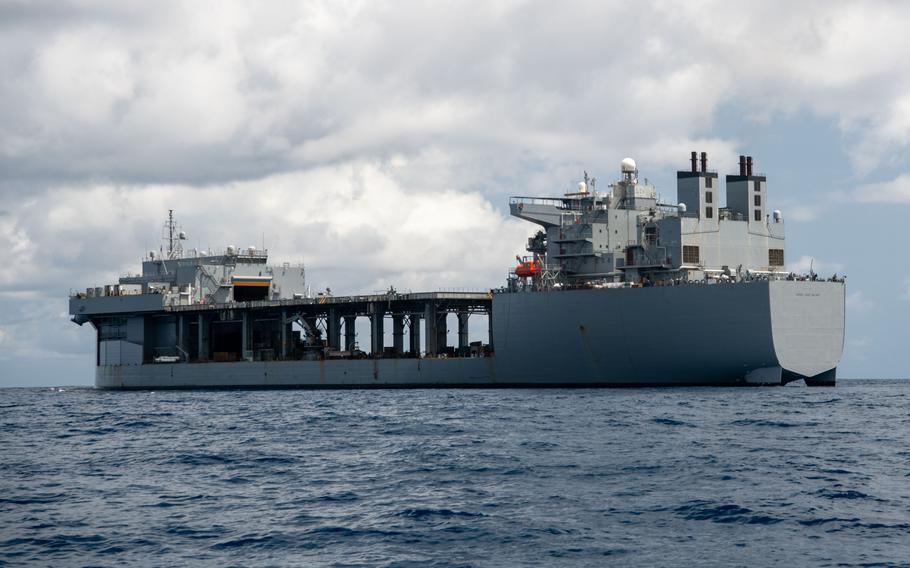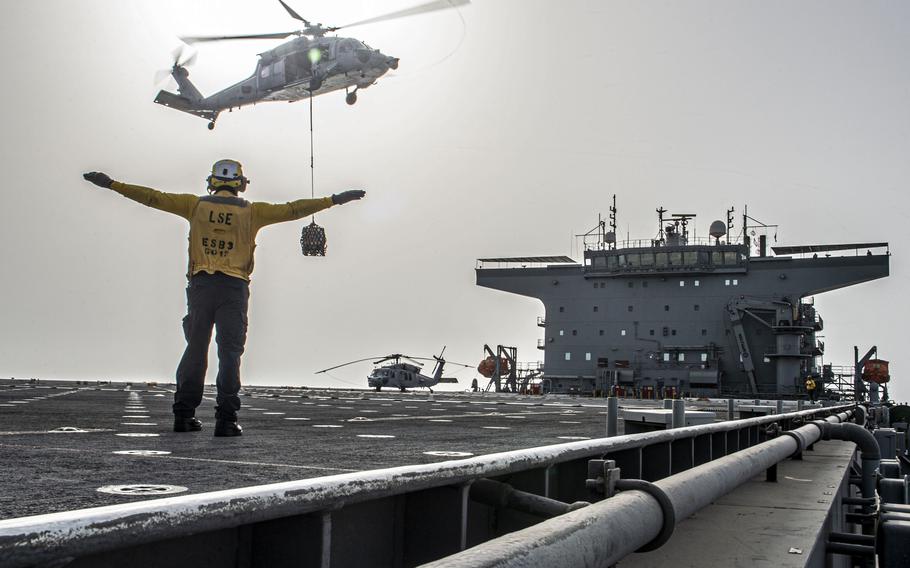
USS Hershel “Woody” Williams transits through the Gulf of Guinea on April 6, 2024. The ship, which is deployed throughout Africa, may be among 17 vessels sidelined as the Navy faces a shortage of civilian mariner manpower. (Ethan Morrow/U.S. Navy)
A Navy proposal to put more than a dozen support ships out of service to ease a crippling shortage of qualified civilian mariners could damage U.S. efforts to counter its competitors in Africa and the Middle East, naval analysts say.
The plan calls for putting the expeditionary sea bases USS Hershel “Woody” Williams and USS Lewis B. Puller, along with 15 other Military Sealift Command support ships, on a lengthy hiatus so the civilian crews staffing them can be retasked.
On Monday, the Navy said it would be inappropriate to comment on the plan given a final decision was pending. USNI News reported last week that Military Sealift wants to sideline 17 vessels in all, citing unidentified officials familiar with the plans.
Sidelining the ships would help the service better cope with a civilian mariner recruiting and retention problem that experts have likened to a national disaster threatening America’s ability to maintain sea power.
Based in Bahrain, Puller has supported missions to disrupt drug and weapons trafficking in the Middle East, among other tasks, as part of the Navy’s work to counter Iranian efforts to arm Houthi militants in Yemen.

Petty Officer 3rd Class Riley Netherland signals an MH-60S Seahawk helicopter on the flight deck of the expeditionary sea base USS Lewis B. Puller in the Gulf of Oman in July 2023. The vessel may be among 17 ships sidelined as the Navy deals with a shortage of civilian mariner manpower. (Elliot Schaudt/U.S. Navy)
Williams, assigned to U.S. Africa Command, is one of the few U.S. military vessels to almost continually transit African waters, a continent considered vital to American security interests.
The ship is part of collective U.S. efforts to build and sustain relationships in Africa, where Chinese interest in building a naval port on the Atlantic Ocean and growing Russian military influence come into play.
“You have to be on the scene where you want to win friends and influence people,” said James Holmes, chair of the maritime strategy program at the Naval War College in Newport, R.I. “If China is on the scene, it’s competing, and it’s the only one competing if we’re not there. We lose by default.”
Absence of the two sea bases also would be a blow to U.S. deterrence efforts, said Steven Wills, a retired Navy officer and research scientist at the Arlington, Va.-based think tank CNA.
He pointed out that the ships also work as evacuation platforms when conventional U.S. amphibious warfare forces aren’t available.
For example, Williams became the primary evacuation platform for Americans during the 2023 military coup in Sudan, he said.
In a world where the U.S. Navy cannot guarantee consistent amphibious ready group presence in the Mediterranean and Red Sea/Persian Gulf region, the (expeditionary sea bases) have proven to be valuable stand in ships and should not be sidelined, Wills said.
The ships in the proposal include two replenishment vessels, an oiler and 12 expeditionary fast transports that, along with Williams and Puller, would be placed into an extended maintenance period. It wasn’t clear how long that would be.
The action would allow Military Sealift to send affected crews to other vessels, USNI reported Aug. 22.
Military Sealift operates about 125 civilian-crewed ships that replenish Navy ships, preposition combat cargo at sea and conduct specialized missions, according to the command’s website.
Many of those ships — including Puller, Williams and U.S. 6th Fleet flagship USS Mount Whitney — are staffed by dual crews of civilian mariners and active-duty sailors.
For example, about 50 civilians are responsible for navigation and maintenance aboard Williams, while about 100 sailors manage air and other operations.
In all, about 5,500 civilians fill about 4,500 billets across Military Sealift. But that number of civilian workers does not allow for the ratio needed to properly crew a ship while giving other mariners much-needed leave time, according to USNI.
The grueling schedule has taken a toll on civilian mariners, many of whom have opted to leave the service, military and maritime historian Sal Mercogliano said Sunday on his account on X, formerly Twitter.
“This has resulted in @MSCSealift churning through personnel,” Mercogliano said.
The proposed reshuffle could ease staffing requirements for Military Sealift by as much as 700 billets and allow for a ratio of workers that would better support time off.
Holmes and Wills concede that the Navy doesn’t have many options when it comes to the plan.
“We are in serious trouble if we can’t produce enough civilian mariners to crew our logistics fleet, a fleet that is already far too lean in terms of ship numbers,” Holmes said. “The question is whether we can get our mojo back, and how.”